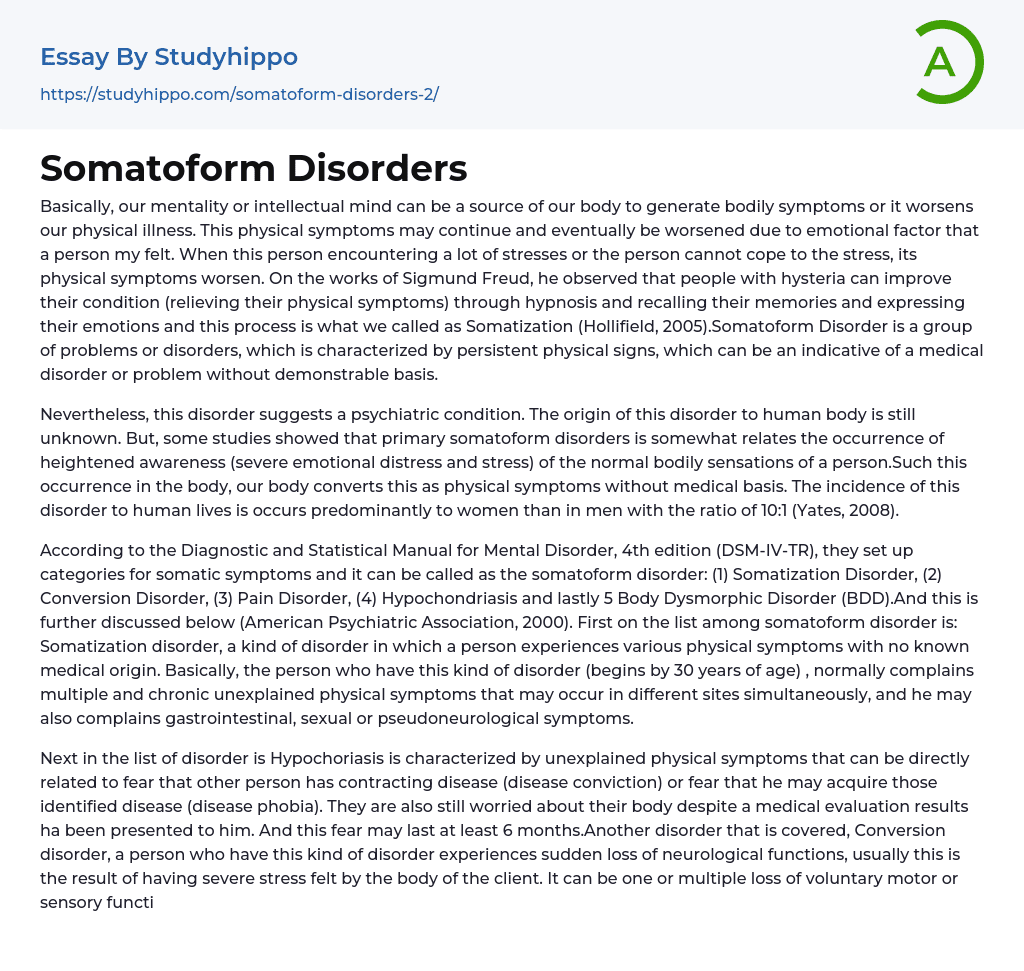The connection between our mental and physical wellbeing is significant. It's possible for our mental state to worsen and prolong any physical symptoms we experience. This is especially true during stressful periods that we struggle to manage. Sigmund Freud discovered that hypnosis and the expression of repressed emotions could help individuals with hysteria relieve their physical symptoms - known as Somatization (Hollifield, 2005). Somatoform Disorder encompasses various medical conditions featuring persistent physical signs that resemble a medical issue but lack an identifiable basis.
Even though the cause of this ailment in humans is unidentified, it falls under the category of a mental health disorder. Studies indicate that primary somatoform disorders are linked to a heightened sensitivity to regular bodily sensations, causing physical symptoms without any medical justification. This disorder is more prevalent among women than men, with a ratio of 10:1 (Yates, 2008).
The Ameri
...can Psychiatric Association in 2000 categorized somatoform disorder into different types, including Somatization Disorder, Conversion Disorder, Pain Disorder, Hypochondriasis, and Body Dysmorphic Disorder (BDD), as stated in DSM-IV-TR. The first type mentioned is Somatization Disorder which presents with multiple physical symptoms without any medical explanation. This condition commonly affects individuals aged 30 years old and above and can cause chronic manifestations such as gastrointestinal issues, pseudoneurological symptoms or sexual dysfunction.
The article covers two types of disorders: Hypochondriasis and Conversion disorder. Firstly, Hypochondriasis is characterized by inexplicable physical symptoms that can be linked to a fear of contracting or acquiring a disease. Despite undergoing medical evaluation, the individual remains anxious about their body for at least six months. Secondly, Conversion disorder involves sudden loss of neurological functions resulting from severe stress o
the body, which can include one or multiple losses of voluntary motor or sensory function.
Reports suggest that patients who exhibit symptoms are not deliberately displaying them, and the loss of function associated with these symptoms does not seem related to medical conditions or cultural responses. Rather, it may indicate psychological connections. Pain disorder is a condition where a person experiences intense localized pain that cannot be attributed to any identifiable medical cause and cannot be alleviated through medication. This type of pain can occur in one or more areas of the body, and those experiencing it do not intend for it to happen.
Body Dysmorphic Disorder, categorized as a somatoform disorder, causes individuals to perceive an imaginary physical flaw. Although it may lead to an intense preoccupation with plastic surgery, it is distinct from other body-related psychological conditions like factitious disorder or malingering. Factitious disorder involves purposefully generating symptoms for personal gain or to avoid responsibilities.
When individuals who are feigning illness obtain what they desire, their physical symptoms will cease. In contrast, those with Factitious disorder intentionally produce physical or psychological symptoms, such as self-harm, in order to garner attention. Many techniques may be employed to treat somatoform disorder, including psychosocial interventions. A nurse or other medical professional may suggest Cognitive Behavioral Psychotherapy to minimize the patient's distress and decrease their desire for medical evaluation. Additionally, psychoeducation is a valuable tool for explaining how stress and emotional distress can contribute to physical symptoms.
Targeted interventions are now available for various types of somatoform disorders. To manage symptoms related to bodily disturbances, medical treatment can be used to reduce physical discomfort. Psychopharmacological treatment is aimed at addressing emotional
disturbances and other coexisting mental health conditions. Techniques like relaxation, biofeedback, and stress management can help reduce emotional and physical arousal. Psychological interventions focusing on attention training, distraction tools, hypnosis or environmental manipulation can also effectively reduce body awareness and physiological disturbances (Looper, 2002).
Individuals with Somatization disorder typically decline psychotherapy, believing that their physical symptoms indicate an illness. Instead, Behavior therapy or hypnosis have shown to be beneficial treatments for Conversion disorder. To prevent the reoccurrence of abnormal gait, which is interpreted as an inappropriate response to stress, stress management counseling is utilized. Hypnosis may also be a potential treatment option for Conversion disorder.
To treat Hypochondriasis, physicians may use different methods such as electromyography biofeedback, behavioral reinforcement with strategic "double bind" therapy, hypnosis combined with lorazepam and amobarbital interviewing. It is important for medical professionals to provide explanatory therapy and answer all patient's questions in order to ease their anxiety. Individuals affected by this disorder may believe that they are overemphasizing their symptoms; however, healthcare providers can educate them about their condition and assist them in expressing their emotions. Psychosocial theorists suggest that those with this disorder tend to internalize stress, anxiety, and frustration rather than expressing them externally.
By encouraging the individual to openly communicate their emotions and incorporating recommended alternative medicine, it is feasible to alleviate their ailment.
- Emergence essays
- Anxiety Disorder essays
- Post-traumatic Stress Disorder essays
- Insanity essays
- Addiction essays
- Anatomy and Physiology essays
- Biodegradation essays
- Cancer essays
- Dental Care essays
- Disability essays
- Disease essays
- Disorders essays
- Health Care essays
- Infectious Disease essays
- Inquiry essays
- Intelligence Quotient essays
- Lung Cancer essays
- Medicine essays
- Neurology essays
- Nutrition essays
- Olfaction essays
- Physical Exercise essays
- Public Health essays
- Sex essays
- Women's Health essays
- World health organization essays
- Adhd essays
- Antisocial Personality Disorder essays
- Anxiety essays
- Bipolar Disorder essays
- Depression essays
- Depression And Anxiety essays
- Dyslexia essays
- Learning Disability essays
- Major Depressive Disorder essays
- Mental Disorder essays
- Mental Illness essays
- Psychosis essays
- Schizophrenia essays
- Stress essays
- Suicide essays
- Apoptosis essays
- Asthma essays
- Black Death essays
- Breast Cancer essays
- Cholesterol essays
- Chronic essays
- Chronic Pain essays
- Death essays
- Diabetes essays




